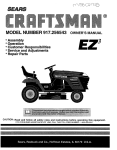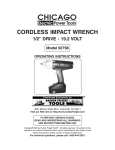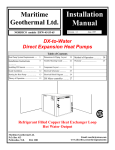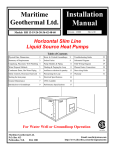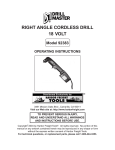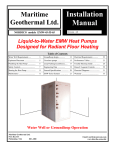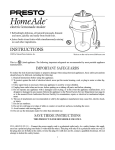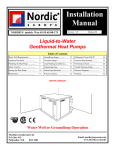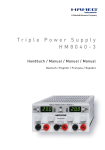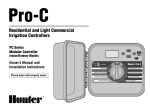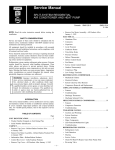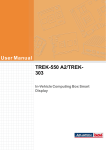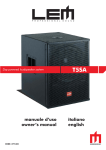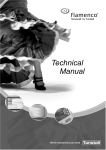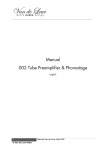Download Installation Manual
Transcript
Maritime Geothermal Ltd. Installation Manual NORDIC® models R-45-55-65 Revision 3.1 Friday, February High Efficiency “R”eversible Liquid Source Heat Pumps Table of Contents Heat Pump System Requirements ..... 3 Groundloop Requirements.......... 13 CFM available ........................... 25 Optimum Placement ....................... 5 Pump Modules ........... 15 Trouble Shooting Guide .............. 26 Plumbing the Heat Pump ................ 7 Antifreeze Solution .......... 14 Electrical Diagrams ..................... 29 Safety Controls .............................. 9 Component Layout ................ 20 Plenum Heater ..................... 31 Starting the Heat Pump ................... 11 Performance Ratings ............... 24 Warranty ................................... 32 Maintenance .................................. 11 Heat Exchanger Pressure Drop .. 25 Horizontal Vertical Water Well or Groundloop Operation Maritime Geothermal Ltd. P.O. Box 413 Petitcodiac, N.B. E0A 2H0 Email:[email protected] www.discribe.ca/nordic Friday, February 04, 2000 Maritime Geothermal Ltd. A NORDIC® Groundwater Heat Pump System Energy Input: Solar Geothermal Groundwater Water Pump System NORDIC® Groundwater Heat Pump Ductwork (Heat Distribution) Disposal of thermally altered water Surface Irrigation Domestic Subsurface Pond/ Return Well Underground Water Page .... 2 Leaching Maritime Geothermal Ltd. Friday, February 04, 2000 NORDIC® Heat Pump System Prerequisites 1. 2. 3. 4. 5. There are five specific parts or sub-systems to a groundwater heat pump installation: The source of energy (groundwater) ......................................... Water Well The method of supplying energy to the heat pump ................. Water Pump System Converting the energy to a useable form ................................... Heat Pump Distributing the heat .................................................................. Ductwork Returning the exhaust water to the earth for reheating .............. Water disposal Water Well Requirements 1. A DRILLED well of 5'' diameter or larger. 2. Well casing properly sealed or grouted into rock. 3. Water flow preferably entering well at a depth of 75 ft. or more. 4. Temperature of well at least 40° F. (Normally 45 °F.) 5. Well must be able to supply requirements of BOTH heat pump and residence usage at the same time with maximum drawdown from static level of 30 ft. Duct Systems A duct system capable of supplying the required air flow is of utmost importance. • Generally allow 100 cfm for each floor grill. • All leads to the grills should be 6'' in diameter (28 sq.in. each). Nordic® R-45 will heat up to 1800 sq.ft. Nordic® R-55 will heat up to 2700 sq.ft. Nordic® R-65 will heat up to 3500 sq.ft. Water Requirements For Nordic® Heat Pumps Note: These are minimum water requirements based on an Model Heat Pump Home Total Nordic R-45 8 Igpm 3 11 Nordic R-55 10 Igpm 3 13 Nordic R-65 12 Igpm 3 15 Assuming at least R-20 walls and R-40 ceiling • • Your main hot air trunks should be at least 75% of the square surface area of leads being fed at any given point. Return air grills should have the same total square surface area as the total of your supply grills. (minimum) The square surface area of your return trunks should Air Flow Available from each heat pump entering water temperature of 46° F. Igpm = Imperial gallons per min. Nordic® R-45 models Nordic® R-55 models Nordic® R-65 models Water Pump System 1. A submersible pump is generally required. 2. Must be able to pump the required water flow listed above at a minimum of 30 psig. at the dynamic pumping depth of your well. 3. Make sure you select the pump using the pump manufacturers pump chart. 4. Use a minimum of 30 gal. equivalent air bladder tank. The Heat Pump A heat pump with Btu output capable of heating the home in all winter weather conditions should be selected as follows: Page .... 3 1600 cfm 1900 cfm 2100 cfm equal the square surface area of the grills being handled at any given point along the trunk. It is VERY IMPORTANT that all turns in both the supply trunks and the return trunks be made with TURNING RADII. Remember that air is a fluid and, just like water, it does not like to go around SHARP corner. Nordic® R-45 could have up to 16 hot air grills. Nordic® R-55 could have up to 19 hot air grills. Nordic® R-65 could have up to 21 hot air grills. Friday, February 04, 2000 Maritime Geothermal Ltd. NORDIC® “R” Series - Open Loop Disposal Methods Page .... 4 Maritime Geothermal Ltd. Friday, February 04, 2000 Discharge Water Methods 1. You do NOT necessarily have to have a return well. 2. 80% of our customers do one of the following with their return or waste water: A. Run it into a drain or ditch. B. Pond, river or stream. C. Leaching field. In most instances if you run the water right out on top of the ground it will soak back into the ground in less than 50 ft. of travel. If suitable care is taken to insure that the drain pipe runs downhill and the end of the pipe is protected by a bale of hay or spruce bows etc. the end of the pipe will not freeze. When snow comes it will usually cover the entire process much like a small spring. The above information is intended to give the prospective user/purchaser some insight as to the general requirements for a successful application of the NORDIC® heat pump. Typical P/T – “Pete’s” Plug & Thermometer Stems Unpacking When the heat pump reaches it's destination it should be unpacked to determine if any damage has occurred during shipment. Any visible damage should be noted on the carrier's freight bill and a suitable claim filed at once. ing and general maintenance can be carried out with a minimum of difficulty. Raising the heat pump off the floor a few inches is generally a good practice since this will prevent unnecessary rusting of the bottom panel of the unit. The heat pump is well constructed and every effort has been made to insure that it will arrive intact, however it is in the customer's best interest to examine the unit thoroughly when it arrives. We recommend that the heat pump be placed on a piece of 2'' Styrofoam covered with 1/4'' plywood. The Styrofoam will smooth out any irregularities in the cement floor while the plywood will distribute the weight of the NORDIC® unit evenly over the Styrofoam. This process will also deaden the compressor noise emitted from the bottom of the cabinet. Optimum Placement The NORDIC heat pump has an air-filter rack which can be removed for easy entry through a doorway or to facilitate As an alternative, several pieces of 2''x 4'' lumber can be moving the unit with a furniture cart. Simply remove the two placed under the unit running from the electrical connection screws which hold the end cap in place, slide the cap off and side to the filter rack side of the heat pump. Laying the 2''x push the rack back off it's rails. When the heat pump is in 4'''s in this manner will give the best support since they will place the filter rack can be reinstalled with the removable end be at right angles with the internal steel compressor and heat (where the filter is removed) facing the exchanger support. direction that allows easiest access for changing the filter. In to Heat Pump To achieve the greatest efficiency, the heat pump should be centrally located Brass fitting in the home with respect to the the condion water tioned space. This design provides the utlines to heat most in economy and comfort and usually The NORDIC heat pump must be supplied can be accomplished in harmony with the with an adequate water supply, since in design of the home. A heating system canessence, water is the fuel for the unit. It is Water not be expected to produce an even imperative that the flow requirements warmth throughout the household when it listed in the engineering section be closely is located at one end of the structure and adhered to. the warm air is transmitted with uninsu1/8” D stem Therlated metal ductwork. Maritime Geothermal Ltd. recommometers & PresIf possible the three main service mends the installation of a water flow medoors should remain clear of obstruction sure gauges attached ter on the discharge line so that the exact for a distance of (2) two ft. so that servicamount of water flowing can be deter- Plumbing the Heat Pump Page .... 5 Friday, February 04, 2000 Maritime Geothermal Ltd. NORDIC® “R” Series Typical Plumbing & Ductwork Page .... 6 Maritime Geothermal Ltd. Friday, February 04, 2000 mined at a glance. Plumbing lines, both supply and discharge, must be of adequate size to handle the water flow necessary for the heat pump. For distances less than 40 ft. from the pressure tank, 3/4'' copper or plastic lines should be run while for longer distances we recommend that 1'' plastic or copper lines should be run to the heat exchanger. Similarly, a 1'' line should be run from the discharge pipe to the method if disposal. Ideally there will be water flow available in excess of the requirement of the heat pump. In such a situation the proper pump can be selected to maintain a pressure of 30 to 40 psig. on the lines when the heat pump is operating. However in some cases a well can supply a heat pump only if the minimum requirement for water is used. Water flow to the heat pump can be controlled very accurately by the installation of a reverse action pressure valve in the discharge line of the unit. Another method of regulating the flow is by the use of a “DOLE” valve. This valve will automatically control the amount of water flowing through it by varying the diameter of a flexible rubber orifice through which the water passes. If either of such valves is needed they can be supplied and installed by your dealer. All water line valves on both the supply and discharge lines should be either BALL or GATE valves since a GLOBE valve will create too much restriction across the line possibly causing the heat pump to trip out on it's low pressure safety cutout control as a result of insufficient water flow. Install a P/T (Pete’s Plug)plug on the Water (IN) and Water (OUT) lines just outside the heat pump so that it is easy to record the water in and out temperatures and pressures accurately. (See Diagram on Page 5) Exposed water lines will have a tendency to sweat when the heat pump is in operation, therefore it is recommended that both the water supply and discharge lines be insulated with suitable insulation. Hot Water Connections Connection to the hot water generator feature of the heat pump is accomplished by teeing into an electric or oil fired hot water tank with a capacity of 40 gal. minimum. A typical piping diagram is shown elsewhere in this manual. Be sure to note the position of the check valve and the direction of water flow. One should be sure the tank is filled with water and is under pressure before activating the heat pump. Slightly loosen the copper union on the hot water discharge pipe to allow air to escape from the system before the unit is started. This step will make certain that the water circulator is floode with water when it is started. Since the pump is water lubricated, damage will occur to the pump if it is run dry for even a short period. The union on the discharge water line may have to be purged of air several times before good circulation is obtained. A hand placed several feet down the line will sense when the water is flowing. The thermostats on the hot water tank should be set to 120°F. since the heat pump has an internal thermostat set at a low of 130°F. By setting the tank thermostats as described, the heat pump will try to keep the tank above the cut-in point Page .... 7 of the electric element settings thus generating hot water from the heat pump only. During summer, or periods of high demand, the electric elements will energize to help make hot water. 3/4" MPT Copper or PVC adapter Vent (if required) 3/4" FPT 2" 1/8" per ft. 2" Typical Condensate Drain connection Air FilReturn 3-1/2" R (Horiz.) - Condensate Drain location NOTE: If (2) shut-off valves are located on the hot water lines as shown in the diagram, be sure that the valves are open when the heat pump is operating. If both valves are closed when the heat pump is operating, water will expand in the hot water heat exchanger and could cause damage to the hot water circulator pump. Condensate Drain You will notice in the piping diagram that there is a small drain pipe to the left of the front door. This drain allows the condensed water vapor which forms during the airconditioning cycle to escape to a suitable area of your selection. On a very humid day there could be as much as 25 gallons of water formed. Care should be taken in the spring to insure that this pipe is not plugged with dust that has collected Friday, February 04, 2000 Maritime Geothermal Ltd. Revision 3.3 Desuperheater Piping Models: R-45-55-65 Style: Horizontal Maritime Geothermal Ltd. Water-to-Air Heat Pumps Date: January 1992 Drawn By: G.Kaye Title: Top & Bottom Access Port Tanks An alternate to the single domestic hot water tank setup is the design shown at left. This design maximizes your benefit from the heat pump desuperheater by allowing more storage and also insures that the water in the final tank has not been mixed with cold water thus reducing the output temperature. The heat pump shown above is a horizontal unit although the two tank technique is applicable to both the vertical and horizontal models. Page .... 8 Maritime Geothermal Ltd. Friday, February 04, 2000 during the winter since the water formed will overflow into the bottom of the heat pump. Water Disposal Methods Water disposal methods vary from area to area however some consideration should be made to prevent the cooled discharge water from immediately coming in contact with the supply source. Generally speaking, returning water to a second well, pond lake or stream is acceptable while returning water to the same well will usually cool the water so much that the heat pump will shut off on it's low pressure / temperature safety control. A return well should be a minimum of 80 ft. from the supply well for residential applications. The water returned to the well will not be necessarily be pumped into the same aquifer, depending on underground conditions, but the return well does have to be able to supply the same quantity of water as the amount you wish to recharge into it. If the static level (level when not being pumped) of a well is high (10 to 20 ft. from the surface) it may be necessary to place a well cap on the well to keep the return water from flowing out the top of the well. This cap is commonly required since a certain amount of pressure is needed to force the return water back down the well if the static level is high. Return wells are not always the answer and to some it may be more satisfactory to pump the water to a pond or away into the woods. Water recharged naturally through percolation into the soil is an alternative to a recharge well. The water discharged will generally soak into the ground within a distance of 50 to 100 ft. If care is taken to make sure the end of the pipe does not freeze then this method of disposal works well. Safety Controls The NORDIC heat pump has two built in safety controls which are designed to protect the unit from situations which could damage it. A. LOW PRESSURE / TEMPERATURE CONTROL The low refrigerant pressure / temperature control is designed to shut the unit down if the refrigerant evaporating pressure becomes too low thus risking the danger of freezing conditions in the evaporator. There are only (4) reasons why this control would activate and they are: • 1. Low water flow. (See requirements for each model. • 2. Low water temperature. (Below 40 °.F.) • 3. Dirty or fouled heat exchanger. • 4. Low refrigerant charge. B. HIGH PRESSURE CONTROL The second safety control is a high pressure safety limit which monitors compressor discharge pressure. This device will not normally trip unless there is an interruption in air flow. Such a situation could occur if the blower motor or fan belt failed or if the heat pump had an extremely dirty air filter. Page .... 9 If either of these controls trips it will activate a LOCK-OUT RELAY which prevents the unit from restarting until power to the control circuit is broken (by turning the thermostat to the OFF position and then back on again) or the electrical supply to the unit is broken by opening the heat pump breaker and then closing it again. If one of these controls trips there is a serious problem with the system and it must be rectified if the unit is to maintain good service. NOTE: Under no circumstances should the heat pump lock-out relay be reset more than twice in an hour. If the the heat pump is shutting off because of LOW or NO water flow then repeated resetting of the unit could cause the heat exchanger to freeze and rupture destroying the heat pump. Electrical Nordic® (R) Models The NORDIC unit is supplied with an opening for 3/4'' conduit nipple on the right blank side of the unit. An additional knockout (1/2") is provided to facilitate connection of a plenum heater blower control wire if required. Above this is another 3/8'' hole for the thermostat wire. A wiring diagram is located inside the electrical box cover for quick reference and although the connections to be made are quite simple, Maritime Geothermal Ltd. recommends that a properly qualified electrician be retained to make the connections and wire the thermostat. The NORDIC unit comes supplied with a thermostat and connections are clearly marked on the control box. Using a 8conductor (18 gauge) wire suitable for the job, connect the terminals in the heat pump electrical box to the corresponding terminals on the thermostat. An additional 4-conductor wire will be required for low voltage control of a NORDIC plenum heater if required. Ductwork Ductwork layout for a NORDIC® heat pump will differ from normal design in the number of leads and size of main trunks required. Air temperature leaving the heat pump is normally 95º to 105º F., much cooler than that of a conventional warm air furnace. To compensate for this, larger volumes of lower temperature air must be moved and consequently duct sizing must be able to accommodate the greater air flow without creating a higher static pressure or high velocity at the floor diffusers. Maritime Geothermal Ltd. recommends that the static pressure be kept below .2 inches of water total. Return ducts should ideally be placed in every room and be sized 50% larger than corresponding supplies. In some instances the number of floor diffusers will actually double when compared to the number that would normally be used for a warm air oilfired furnace. NOTE: See the duct sizing chart in the engineering section of this manual. Starting the Heat Pump Friday, February 04, 2000 Maritime Geothermal Ltd. Revision 3.3 Color: Caissie Grey Models: R-45-55-65 Style: Horizontal Maritime Geothermal Ltd. Hot Water Tank Connections Date: Friday, February 04, Drawn By: G.Kaye Title: Top Access Port tank piping Diagram above shows a horizontal “R” series heat pump connected to a heat pump pre-heat tank with both the inlet and exit access ports at the top of the tank. Always observe the “HOT IN” and “HOT OUT” markings on the heat pump and the direction of the check valve when connecting your linesets. Page .... 10 Maritime Geothermal Ltd. Friday, February 04, 2000 BEFORE starting the heat pump the following areas should be rechecked to assure proper operation. 1. Check all high voltage field wiring and electrical connections inside the control box for good connection. 2. Check all low voltage thermostat to make sure they are connected properly. Place thermostat HEAT-OFF-COOL switch in the OFF position. 3. Turn on the main power switch. Allow the power to remain ON without starting the unit for a period of 4 hours. Refrigerant migrates to the compressor oil when the compressor is unheated. A crankcase heater is standard equipment on your heat pump and it will warm the compressor, dispelling the liquid refrigerant. Compressor damage can occur if the heat pump has been brought in from a cold location and immediately started up. 4. Turn on the water supply and check all plumbing for leaks. 5. Check the hot water tank to be sure it is filled with water before energizing the circuit. NOTE: In a low ambient air start-up the hot water tank should be energized for at least 4 hours before the heat pump is started. A combination of low air temperature and 45º F. water in the hot water tank can sometimes cause the unit to shut down on it's low pressure control. If this happens close ONE valve in the hot water circuit to temporarily shut off the flow to the hot water generator. Do not shut off both valves since water expanding in the hot water generator loop may cause damage to the circulator pump housing. When the home has come up to temperature open the valve for normal hot water operation. Slightly open the union on the hot water discharge pipe to make sure that all air is out of the system and the circulator pump is flooded with water. 6. Make sure the air filter is clean and in place. 7. Vacuum out any dust and debris that may have collected in the unit during installation. Check the condensate drain to be sure that it is free of obstruction. 8. Make sure the unit is sitting level so that condensate water will not overflow the catch pan. 9. Make sure the proper time-delay fuse has been installed in the fuse box. 10. Have the following tools on hand and know how to use them. • A refrigeration gauge set. • An electronic or other accurate thermometer • An amprobe. • A water flow meter. 11. Connect your refrigeration gauge set. 12. After the 4 hour warm-up period place the thermostat function switch in the HEAT position, turn up the thermostat. The compressor, blower and hot water circulator will start. NOTE: If the unit is equipped with an electric TACO water valve the blower will start first followed by the compressor in 30 to 60 seconds. When the TACO water valve is fully open, an internal switch activates the compressor circuit. mately 53 to 58 psig. while the head or discharge pressure (red gauge) should be in the area of 225 to 275 psig. Record this information on the warranty test card. 14. Using an electronic thermometer or other accurate thermometer, record the supply water temp.''IN'' and the water temperature ``OUT''. The outlet water temperature should be from 4° to 7° F. cooler than the inlet water temperature. 15. Record the supply water flow in gpm. 16. Record the return air temperature by drilling a small hole in the return air plenum approximately 2 ft. from the filter rack and inserting the thermometer's sensing device. 17. Similarly record the discharge air temp. There should be a rise across the air exchanger of from 25° to 35°F. 18. At the electrical disconnect switch place the amprobe jaws around the supply wires and record the current in each. 19. Place the thermostat function selector in the COOL position and turn down the stat to a temperature that will cause the air-conditioning to begin. When the thermostat selector switch is set in the COOL mode the reversing valve will be energized. The blower should start followed by the compressor. The outlet temperature will be approx. 10° to 20°.F. cooler than the return air temp. General Maintenance As with any piece of equipment there will eventually be some maintenance to be done on the heat pump. Several areas will need attention and they are as follows: 1. Change the air filter when required. 2. Oil the blower motor once a year. 3. Clean the groundwater heat exchanger. 4. Inspect the blower belt for cracks & wear. 5. Insure the condensate drain is clean. Reversible NORDIC® heat pumps are equipped with coaxial type heat exchangers. These heat exchangers are not manually cleanable however they can be cleaned with a sulfamic acid solution commonly marketed under the trade name "Iron-Out". If you suspect that the water being pumped through the unit is of a poor quality or you notice a decrease in performance after several years of use it may be necessary to have the liquid heat exchanger cleaned. Maritime Geothermal recommends that a qualified serviceman be retained to carry out this procedure since the solution involved is highly corrosive. 13. Observe the readings on the high and low pressure gauge set. When the home reaches a temperature of 65 to 70 °.F. the suction pressure (blue gauge) should be approxiPage .... 11 Friday, February 04, 2000 Maritime Geothermal Ltd. Diagram A. Design # 2 Design # 1 Diagram A. Shown above are several of the many possible horizontal loop layouts which have been successfully employed in various types of ground conditions. Design # 1 Shown is a typical reverse return header system and 2 parallel loops. On a 2 ton system each of these loops would be 500 ft. long with 4 ft. spacing between the “U” sections, 10 ft spacing between the loops and buried 6 ft. underground. Design # 2 is a single loop of 1-1/4” to 1-1/2” diameter pipe with a length of 500 ft. x the tonnage of the system and buried to a depth of 6 ft. underground. Individual runs of pipe should be kept a minimum of 10 ft. apart. Diagram B. Design # 3 Design # 4 Design # 3. Shown is a vertical borehole reverse-return header system. Vertical systems generally require 125 to 175 ft of borehole per ton of heat pump for successful heat transfer to take place with the earth. Boreholes should be spaced a minimum of 10 ft apart while if land is available, 15 ft. spacing will produce better results. Boreholes should be tremie grouted from bottom to top with bentonite or a mixture of bentonite and neat cement for proper conduction with the earth. Design # 4. Shown here is a typical series loop design using 1-1/4 to 1-1/2” pipe for the loops. Some designs incorporate a double “U” tube assembly down the well which allows for better heat transfer between the earth and the loop. NOTE Many other loop designs are in common use throughout North America. For a more comprehensive manual on earthloop design refer to our Earthloop Design Manual or contact IGSHPA (International Ground Source Heat Pump Association) and request their earth systems dealer training manual. Page .... 12 Maritime Geothermal Ltd. Friday, February 04, 2000 RHR- Series SeriesClosed ClosedLoop LoopInstallation InstallationInformation Information Horizontal Groundloops Introduction Many commercial buildings select a vertical or horizontal closed loop as the earth heat exchanger either because of a lack of available groundwater or for the reduced maintenance costs which can be obtained when compared to open loop systems. Often the problems which occur in a geothermal system are associated with the the wells, pumps, or the direct result of utilizing poor quality water or water which is contaminated with sand or other foreign materials. Such contamination can cause premature failure with pumps, water valves, heat exchangers and return wells. To reduce these problems to a minimum a closed secondary heat exchange system is constructed with Type 3408 Polyethylene Plastic Pipe specifically engineered for the job. Materials such as PVC and polybutylene are not recommended since their underground joining process is not as reliable as the fusion process used with type 3408 polyethylene. The earthloop heat exchanger can consist of a single long length of plastic commonly called a series style heat exchanger or more commonly is found as a number of parallel loops connected to a reverse return header system. The series system for homes or light commercial applications up to 10 tons normally is constructed with 1-1/4” to 2” diameter pipe while the parallel system uses multiple branch loops from 3/4” to 1” connected to a larger header pipe system of 1-1/4” to 2” diameter. The parallel system offers several advantages such as: • Less expensive pipe. • Easier to handle the smaller pipe. • Lower pressure drop • Smaller circulator pump(s) Of course on larger commercial systems it would not be unusual to find header systems with up to 6” diameter pipe for fluid flow into and out of the building. Socket Fusion Mechanical joints or metal fittings of any kind are not acceptable underground in an earth loop system due to large temperature fluctuations which may loosen and break clamps and the possibility of eventual corrosion perforation in couplings and “T’s”. Fittings and joints are socket or butt fused together into one contiguous unit using a technique developed by the gas industry. A heater tool with the appropriate faces heats both the pipe and fitting for a prescribed period of time and then the two pieces are quickly removed from the heater, inserted together and held in place until the joint cools. When properly done the resulting joint is stronger than the original pipe with no chance of leaks or breaks. For more information on butt and socket fusion techniques see our website at (http://www. discribe.ca/nordic/fusion.htm) or request a copy of the Central Tools Butt and Socket fusion manual. Horizontal groundloop systems are most commonly used where land is readily available since they are cheaper to construct than their vertical counterparts. Although many configurations are available, we have found that a parallel system with one (1) 500 ft. “U” pipe per ton placed in a 250 ft. x 4 ft. wide x 6 ft. deep trench is easy to construct and provides ample ground impact area to adequately supply a 32° F or better Entering Fluid Temperature to the heat pump even in the most severe winter months. (See opposite Diagram A.) Several companies including “Thermalworks” and the International Ground Source Heat Pump Association (igshpa) provide modeling software to size the heat pump to the home and then size the loop to the demand of the home and heat pump. Consideration is given to many factors such as type of ground, moisture content and configuration of loops desired. It is often possible to shorten loop lengths and resulting costs when using some of the newer “Slinky” designs of earthloops. A comprehensive manual dedicated entirely to the installation of Groundloops is available from Maritime Geothermal Ltd. which describes in detail the techniques involved in installing a closed loop system. Vertical Groundloops Vertical groundloop systems are generally the system of choice for commercial and institutional buildings since the land area available is often limited to parking lots with some adjacent landscaped areas. Boreholes of 4 to 6 in. diameter are drilled with conventional drilling equipment usually to a depth of less than 300 ft. Each “ton” of heat pump installed requires approximately 150 ft. of borehole. The 3/4” to 1”plastic pipe “U” tubes are fused together using socket fusion techniques and then pressure tested for leaks at 100 psig. using either water or air. Provision should be made to allow enough extra pipe to extend from the boreholes to the proposed location of the header system. Prior to inserting down the hole the assembly must be filled with water so that buoyancy will be at a minimum when inserting the “U” tube. Cap the ends so that mud and debris cannot enter the loops during insertion and grouting. A piece of heavy rebar or galvanized pipe is attached to the bottom 10 to 15 ft of the “U” tube with tape to add weight to the assembly and also prevent it from curling up and gouging into the side of the borehole during insertion. The entire length of the assembly should be taped every 10 ft. to create greater rigidity in the “U” tube assembly as it is installed in the borehole. The “U” tube is inserted into the borehole and the borehole is tremie grouted from bottom to within 10 ft. of the top with a mixture of neat cement and bentonite or 100% bentonite. When using bentonite refer to the manufacturers instructions for mixing and select a product that provides a total solids content of from 25 to 30% when Page .... 13 Friday, February 04, 2000 Maritime Geothermal Ltd. Page .... 14 Maritime Geothermal Ltd. Friday, February 04, 2000 mixed. Horizontal trenches from 4 to 6 ft. deep are dug alongside the boreholes to the building so that a reverse return (first pipe out on the supply line is the last pipe back on the return line) header pipe arrangement can be constructed to tie all the loops together. Lay out the header system so that air cannot be easily trapped in the header using a technique approved by igshpa or the local governing authority. Use a shovel to break away any ground between the trench and the Table 1. Antifreeze Percentages by Volume Protection down 10°F Methanol 25% Propylene Glycol 38% 15°F 21% 30% 20°F 16% 22% 25°F 10% 15% boreholes and dig a relief no less than 30 times the diameter of the pipe to allow the pipe to bend to the header pipe without kinking. Be very careful not to disturb the original ground under the relief so that you do not have to worry about the pipe being kinked through compaction of the earth under the pipe after the trench is backfilled. Fuse the individual smaller loops to the main header loops and extend these into the home by drilling through the concrete wall or by rising up the outside of the basement wall or slab and entering the structural part of the home or building above grade. Any piping that comes within 10 ft. of the structure should be insulated with 3/8” to 1/2” closed cell armaflex insulation to prevent freezing from occurring near any structural part of the building. Likewise, all piping inside the building must be insulated to prevent condensation and subsequent dripping onto floors or walls. Circulator Pump Module “Pete’s plugs” should be installed on both the entering and leaving lines at the heat pump. The P/T plug will allow the installer or homeowner to check water flow through the loop by measuring the pressure difference through the heat exchanger and comparing this pressure drop to that of the appropriate model in the engineering section. (see Pressure Drop vs. Water Flow Table) Flushing & Purging the Earthloop Once the earthloop has been installed and all connections are completed to the heat pump and pumping station the entire plumbing system should be pressure tested with air to 60 psig. to make sure there are no leaks on any of the inside fittings. Soap all joints and observe that the pressure remains constant for 1 hour. NOTE: If you use pressure gauges permanently installed on the system as in the case of a demonstration situation etc. be careful not to exceed the maximum pressure rating of the gauges to avoid damage to their mechanism. When satisfied all connections are leak free, release the air pressure and connect a flush cart (see diagram) to the flushing access ports at the pump station. A temporary flushing system can alternately be constructed using a 45 gal. barrel and a pump with sufficient volume and head capability to circulate fluid at a velocity of at least 2 ft./min. through all parts of the loop. Begin pumping water through the earthloop making sure that the intake of the pump stays submerged at all times by continuously adding water from a hose etc. Water flowing back on the return line should be directed below the water level in the barrel or flush tank to prevent air being mixed with the outgoing water. Once the lines have been filled and no more air bubbles are appearing in the line, adjust When the groundloop has been brought inside the home or building to the location of the heat pump it must be connected to the pump module which generally consists of (1) Grundfoss® Model UPS 26-99 or Taco® Model 0011 pump for systems up to 3 ton and (2) pumps for systems up to 5 ton. These units must be able to pump at least 2.5 to 3 USgpm. per ton of heat pump for proper operation of the system. To calculate the size of pumps required use the pressure drop tables for the diameter and type of tubing used along with all elbows, T’s etc and the pressure drop through the unit’s heat exchanger to arrive at: ( total ft of head) x (3 gpm/ton) x (No. of tons) Table 2. US Gal. of fluid per 100 ft. of pipe Type of Pipe Diameter Volume (US gal.) Copper 1” 4.1 1-1/4” 6.4 1-1/2” 9.2 Rubber Hose 1” 3.9 Polyethylene 3/4” IPS SDR11 2.8 1” IPS SDR11 4.5 1-1/4” IPS SDR11 8.0 1-1/2” IPS SDR11 10.9 2” IPS SDR11 18.0 Heat Exchanger Average 1.5 Flush Cart Tank 15”D x 3 ft. high 28 Heat Pump to Circulator Piping The heat pump must be connected to the circulator pump module with a lineset suitable for the flow required with minimum pressure drop. Common line sizes would be 3/4” rubber or plastic for heat pumps from 1 to 2.5 ton while for unit sizes 3 through 5 ton, 1” lines should be used. The installation of P/T plugs (pressure / temperature) pronounced the flow valves to circulate water through the heat pump using the same technique as described above. When all air is removed reverse the flow of water through the lines by Page .... 15 Friday, February 04, 2000 Maritime Geothermal Ltd. Revision 3.3 Two Pump Kit Models: R-45-55-65 HP Style: Vertical Maritime Geothermal Ltd. Water-to-Air Heat Pumps Date: Friday, February 04, Drawn By: G. Kaye Page .... 16 Title: Loop Pump Module Maritime Geothermal Ltd. Friday, February 04, 2000 Water Flow Rate vs. Pressure Drop Through Heat Exchanger Model 4 usgpm 6 usgpm 8 usgpm 10 usgpm 12 usgpm 14 usgpm 1.5 1.5 3.7 5.0 6.5 R-55 1.6 2.4 3.4 4.5 5.7 R-60 1.1 1.8 2.4 3.1 3.9 R-45 16 usgpm Nordic® R-Series interchanging the flush cart lines and purge again. You will be able to visibly tell when all air is removed. Installing Antifreeze Solution In most mid and northern areas of the US and in all of Canada it is necessary to condition the loop fluid by the addition of some type of antifreeze solution so that it will not freeze during operation in the winter months. This antifreeze is required because the loop fluid will normally reach a low entering temperature of 28°F to 32°F. and refrigerant temperatures inside the heat pump’s heat exchanger may be as low as 20°F cooler. See the antifreeze concentration chart at left for details of freeze protection afforded under different concentrations. NOTE: Add enough antifreeze to allow for a temperature 20°F lower than the expected lowest loop fluid temperature entering the heat pump. NOTE: Although many different antifreeze solutions have been employed in geothermal systems, the alcohols such as methanol or ethanol have the most desirable characteristics for earthloop application. The overall heat transfer characteristics of these fluids remain high although care must be taken when handling pure alcohols since they are extremely flammable. Once mixed in a typical 25% by volume ratio with water the solution is not flammable. In situations where alcohols are not allowed as a loop fluid due to local regulations then propylene glycol is a non-toxic alternative which can be substituted . Propylene glycol should only be used in cases where alcohols are not permitted since the heat transfer characteristics are less desirable and it becomes more viscous at low temperatures which increases pumping watts. The volume of fluid that your loop system holds can be closely estimated by totaling the number of ft. of each size pipe in the system and referencing Table 2. the for approximate volume per 100 ft. When the volume of the loop has been calculated and the appropriate amount of antifreeze is ready for addition by referencing Table 1. , drain the equivalent amount of water from the flush cart or mixing barrel and replace it with the antifreeze. When using alcohols be sure to inject it below the water line to reduce initial volatility of the pure antifreeze. If the loop is large and the tank is small it may be necessary to refill the tank with antifreeze several times to get all the antifreeze into the loop. Pump the loop for 5 to 10 minutes longer to insure the remaining fluid has been well mixed. Initial Pressurization At this point open all valves in the flow circuit and slowly close off the supply and return flush cart valves in a manner that leaves about 20-30 psig. on the system. If an air bladder expansion tank is used it should be charged to the above pressure before actual water pressure is put on the system . Systems employing a commercially available loop pump kit that do not have an expansion tank, thermometers and pressure gauges will experience a greater fluctuation of pressure in the loop between winter and summer. This fluctuation is normal since expansion and contraction of the loop fluid must be handled by the elasticity of the plastic loop. Pressurize the loop to a pressure of 45 psig. when installing a system in the fall going into the heating season. If installing in spring or summer charge to 25 psig. After operating the machine for a period of time, any residual air in the system can be bled off through valved vertical standpipes in the pump module. If pressure drops below 25 psig. add additional water / antifreeze mix with the purge pump to bring the pressure back to the original setting. Inserting Plastic “U” tube in 4” Borehole Page .... 17 Friday, February 04, 2000 Maritime Geothermal Ltd. Duct Sizing Guide Required Diameter CFM in inches Return Air Required Diameter CFM Rectangular Equivalents 37 5 2.25 x 10 3x8 3.5 x 6 4 x 5.5 5x5 63 5 2.25 x 10 3x8 3.5 x 6 4 x 5.5 100 6 3.25 x 10 4x8 5x6 152 7 3.25 x 14 4 x 11 212 8 4 x 15 226 8 277 5 37 5x5 6 63 5.5 x 5.5 6x6 7 100 5 x 8.5 6x7 6.5 x 6.5 8 152 5 x 12 6 x 10 7x8 8x8 9 212 4 x 15 5 x 12 6 x 10 7x8 8x8 10 226 9 5 x 15 6 x 12 7 x 10 8x9 8.5 x 8.5 10 277 304 9 5 x 15 6 x 12 7 x 10 8x9 8.5 x 8.5 12 304 393 10 6 x 15 7 x 13 8 x 11 9 x 10 9.5 x 9.5 12 393 411 12 7 x 18 8 x 16 9 x 14 10 x 12 11 x 11 12 411 655 12 7 x 18 8 x 16 9 x 14 10 x 12 11 x 11 14 655 680 14 8 x 22 9 x 19 10 x 17 11 x 15 12 x 14 13 x 13 14 680 995 14 8 x 22 9 x 19 10 x 17 11 x 15 12 x 14 13 x 13 16 995 1325 16 8 x 30 10 x 22 12 x 18 14 x 16 15 x 15 18 1325 1450 16 8 x 30 10 x 22 12 x 18 14 x 16 15 x 15 20 1450 1750 18 8 x 40 10 x 30 12 x 24 14 x 20 16 x 17 16.5 x 16.5 20 1750 2000 18 8 x 40 10 x 30 12 x 24 14 x 20 16 x 17 16.5 x 16.5 22 2000 2250 20 10 x 38 12 x 30 14 x 26 16 x 22 18 x 19 18.5 x 18.5 22 2250 2600 20 10 x 38 12 x 30 14 x 26 16 x 22 18 x 19 18.5 x 18.5 24 2600 2900 22 12 x 36 14 x 30 16 x 26 18 x 23 20 x 20 24 2900 3400 22 12 x 36 14 x 30 16 x 26 18 x 23 20 x 20 26 3400 3600 24 14 x 38 16 x 32 18 x 28 20 x 25 22 x 22 26 3600 4300 24 14 x 38 16 x 32 18 x 28 20 x 25 22 x 22 28 4300 5250 26 16 x 38 18 x 32 20 x 30 22 x 24 24 x 24 30 5250 6125 28 18 x 38 20 x 34 22 x 30 24 x 28 26 x 26 32 6125 6500 28 18 x 38 20 x 34 22 x 30 24 x 28 26 x 26 34 6500 7250 30 20 x 40 22 x 38 24 x 32 26 x 30 28 x 28 34 7250 7800 30 20 x 40 22 x 38 24 x 32 26 x 30 28 x 28 36 7800 8500 32 22 x 40 24 x 38 26 x 34 28 x 32 30 x 30 36 8500 9200 32 22 x 40 24 x 38 26 x 34 28 x 32 30 x 30 38 9200 9800 34 24 x 42 25 x 40 26 x 38 28 x 34 30 x 32 31 x 31 38 9800 10900 34 24 x 42 25 x 40 26 x 38 28 x 34 30 x 32 31 x 31 40 10900 28 x 40 30 x 36 32 x 34 33 x 33 30 x 42 32 x 38 34 x 36 35 x 35 30 x 45 34 x 40 36 x 38 37 x 37 Page .... 18 ` Maritime Geothermal Ltd. Friday, February 04, 2000 NORDIC® Series R-45-55-65 Engineering and Performance Data Friday, February 04, Page .... 19 Friday, February 04, 2000 Maritime Geothermal Ltd. Revision 2.3 Color: Caissie Grey Models: R-45-55-65 Style: Vertical Maritime Geothermal Ltd. Water-to-Air Heat Pumps Date: January 1992 Drawn By: G. Kaye Page .... 20 Title: Cabinet & Piping Layout Maritime Geothermal Ltd. Friday, February 04, 2000 Revision 2.3 Color: Caissie Grey Models: R-45-55-65 Style: Horizontal Maritime Geothermal Ltd. Title: Cabinet & Piping Layout 1.25 2.50 26.07 DOOR 19.00 4.22 18.00 Refrigerant Air Coil Filter rack area 29.00 Drawn By: G. Kaye 1.00 Date: January 1992 33.00 Water-to-Air Heat Pumps Electric Box BACK SIDE (Return Air Side) 52.00 22.00 28.00 BLOWER DOOR 1.00 FRONT DOOR SIZE 28"W x 31"H 31.00 Actual G-12 14.00 Blower opening 13.5" x 15.5" 2.00 3.19 1.00 2.66 16.15 27 .0 0 FRONT VIEW 17.13 6.99ø 4.00 0 .0 52 3.50 3.50 RIGHT SIDE DOOR 4.50 33.00 7.50 33.00 5.00 5.00 3.25 22.00 1.00 0.63 LEFT SIDE DOOR 31"H x 22"W 33.00 31.00 27.00 LEFT SIDE VIEW1.75 Page .... 21 Friday, February 04, 2000 Maritime Geothermal Ltd. Thermostat Disconnect Switch Electrical Supply and Thermostat Wire Sizes Model R-45 R-55 R-65 45,000 55,000 65,000 29 32 37 # 8-3 # 6-3 # 6-3 Max. Fuse Size 40 40 50 Max. breaker size 40 40 50 # 18 # 18 # 18 8 8 8 Nominal BTU output Min. circuit ampacity Minimum wire size Thermostat wire size Thermostat conductors Domestic Hot Water Generator Specifications Temperature (IN) °F. Temp (OUT) °F. Temperature Rise °F. % of Total R-45 (Igal/hr) R-55 (Igal/hr) R-65 (Igal/hr) 40 150 110 20 10 11.8 14.5 45 150 105 18 9.4 11.1 13.7 50 150 100 15 8.33 9.8 12.1 60 150 90 12 7.33 8.6 10.6 75 150 75 10 7.33 8.6 10.6 90 150 60 8 7.33 8.6 10.6 110 150 40 5 6.87 5.4 10 Page .... 22 Maritime Geothermal Ltd. Friday, February 04, 2000 Maritime Geothermal Ltd. NORDIC® “R” - Series Premium Features - Reversing Series • • • • • • • • • • Return Air Filter Oversize high efficiency air coil. Belt drive blower with ball bearings. Non sticking reversing valve. High efficiency ball bearing, PSC style motor. Galvanized drip tray. Sight glass (optional) Suction accumulator. Bi-flow filter driers. Thermostatic ex- • • • • • • • • • • pansion valve. Hot Water (IN) Hot Water (OUT) Hot Water circulator High & Low access ports. Slow closing water valve. High Efficiency coaxial heat exchanger. Supply water (OUT) Supply water (IN)] Insulated water coil. High efficiency Tecum- (Front) Plumbing side • • • • • Baked enamel cabinet with satin galvanized condensate tray and floor. Components accessible from three sides. Heavy duty electrical components. Hard start kit on all models. Blower motor field • • • • • (Back) Electrical Box Side Page .... 23 replaceable. Remote reset lock-out relay system. Acoustically insulated cabinet. Cabinet spot welded together for superior strength. Removable and reversible filter rack. Friday, February 04, 2000 Maritime Geothermal Ltd. Capacity Data Model R-45-HAC (nominal 3 ton) Heating EWT Igpm Lpm LWT Diff HAB Pres Drop EAT LAT Diff Btu's Out Comp Amps Comp Watts Blower Amps Blower Watts Total Watts COP CSA COP Suct Disc Pres 70 8 36 61 8.8 40135 5.47 70.2 98 28 52875 17.3 3250 3.92 386.6 3636.9 4.2 3.4 80.4 263 61 8 36 53.6 7.7 34984 5.41 70.5 95 25 46408 16.9 3133 4 387.1 3520.2 3.9 3.13 69.7 251 55 8 36.3 48 7.2 34712 5.71 70.2 94 24 45481 16.4 3040 4.32 379.7 3420 3.9 3.13 63.8 243 45 8 36.2 39 6 28842 5.88 70 91 21 40592 15.7 2879 4.25 384.6 3263.7 3.6 2.9 52.2 227 38 8 36 32.2 5.4 24632 69.8 88 19 35562 15.4 2703 4.29 396.8 3100.1 3.4 3.14 43.8 209 32 8 36.2 27 4.8 22007 5.21 70.2 87 17 32892 14.7 2606 4.15 403.7 3009.3 3.2 2.99 38.5 201 LWT Diff Water Pres Output Drop EAT LAT Diff Sens. cooling Latent Total Cooling Cooling Comp. Amps Comp Watts Blower Amps Blower Total Watts Watts EER CSA EER 10549 40730 12.38 1956 4.28 407 2363 17.2 12.7 407 2725 14.1 10.8 407 2890 13.2 12.3 5.3 Cooling EWT Igpm Lpm 50 8 36 60.6 10.8 40987 5.38 79.5 64 16 30082 70 8 36.2 79.7 10.1 36785 5.41 79.7 65 15 29125 9103 38502 13.67 2317 4.23 77 8 36.2 86.9 80.2 65 15 29696 8211 38427 14.27 2484 4.17 Comp: ZR40K1 Scroll 90 8 36 99.7 Voltage: 230/1/60 9.7 36755 5.41 BM: HE / .33 Marathon 9.6 35813 5.35 79.9 66 14 Entering Air: 70DB / 60WB G-10 Blower 27472 7615 CFM: 1850 2-row / 6-circuit air coil 34878 15.5 2821 4.16 BTSSC-60 water coil 412 3232 10.8 10.1 External Static: .15” WC In accordance with ARI 325 & ARI 330 standards and CAN/CSA C446-M94 Capacity Data Model R-55-HAC (nominal 4 ton) Heating EWT Igpm Lpm LWT Diff HAB Pres Drop EAT LAT Diff Btu's Out Comp Amps Comp Watts Blower Amps Blower Watts Total Watts COP CSA COP Suct Disc Pres 70 10 45.2 60.8 9.2 55223 8.68 70 115 45 69507 21.9 4686 3.26 302.6 4988.8 4.1 3.3 80.4 287 60 10 45.2 52.7 7.6 45619 8.74 70.2 109 39 60529 19.7 4271 3.3 309.9 4581 3.9 3.08 68.1 262 55 10 45.2 48.2 7 41975 8.65 69.8 106 37 57229 18.6 4051 3.33 308.4 4359.7 3.9 3.03 62.2 249 45 10 45.2 39.2 5.9 35271 8.83 69.6 100 30 48898 17.2 3680 3.36 324.1 4004.2 3.6 2.76 51.5 227 39 10 45.2 33.3 5.4 29991 8.94 70.9 98 27 43980 16.2 3407 3.45 319.7 3726.3 3.5 3.16 44.1 214 32 10 45.2 27.3 4.9 26789 9.03 69.8 94 25 39563 15.1 3211 3.47 318.7 3529.9 3.3 2.98 38 202 LWT Diff Water Pres Output Drop EAT LAT Diff Sens. cooling Latent Total Cooling Cooling Comp. Amps Comp Watts Blower Amps Blower Total Watts Watts EER CSA EER 80.1 56 25 38410 21940 61107 14.8 3104 3.39 330 3434 17.8 14.3 80.4 57 24 36618 20729 58064 15.81 3363 3.36 324 3686 15.7 12.8 80.1 58 23 35149 18045 54121 17.01 3636 3.4 340 3976 13.6 11.2 3832 3.38 334 4165 12.8 10.7 Cooling EWT Igpm Lpm 50 8 36 60 8 36.3 70 8 35.8 64.9 14.9 59450 5.8 74.1 14.4 56902 5.83 84 14 53146 5.56 Comp: AV5549G BM: HE / .33 Marathon Voltage: 230/1/60 Entering Air: 70DB / 60WB CFM: 1850 77 8 36.2 91 G-10 Blower 13.8 52035 5.65 80.4 58 4 row / 12-circuit air coil 22 BTSSC-84 water coil 34326 18545 53513 17.79 External Static: .2” WC In accordance with ARI 325 & ARI 330 standards and CAN/CSA C446-M94 Page .... 24 Maritime Geothermal Ltd. Friday, February 04, 2000 Capacity Data Model R-65-HAC (nominal 5 ton) Heating EWT Igpm Lpm LWT Diff HAB Pres Drop EAT LAT Diff Btu's Out Comp Amps Comp Watts Blower Amps Blower Watts Total Watts COP CSA COP Suct Disc Pres 70 12 54.1 61.3 8.5 61029 6.88 70 111 42 82262 31.2 6454 8.22 515 6969 3.5 3.21 78.8 268 60 12 54.2 52.3 7.6 54706 6.94 70 107 38 74313 28.6 5873 8.65 534 6407 3.4 3.14 66.9 250 50 12 54.3 48.4 6.8 48989 7.06 71 105 35 68601 27.2 5609 8.46 521 6131 3.3 3.08 61.5 241 45 12 54.1 43.7 6.3 45156 7.09 70 103 33 65208 26.17 5321 8.33 516 5837 3.26 2.95 56 230 40 12 54.2 34.9 5.2 37399 7.33 70 98 28 56473 23.7 4808 8.59 536 5344 3.1 2.78 46.5 210 32 12 54.3 27.3 4.7 30871 7.8 69.6 95 25 50379 22.2 4452 8.05 513.6 4965 3.0 2.77 39.7 200 LWT Diff Water Pres Output Drop EAT LAT Diff Sens. cooling Latent Total Cooling Cooling Comp. Amps Comp Watts Blower Amps Blower Total Watts Watts EER CSA EER Cooling EWT Igpm Lpm 50 8 36.3 67.8 17.6 66472 3.21 80.1 58 23 43189 25046 69127 23.85 3962 8.0 433 4395 15.7 14.1 60 8 36.2 77.7 17.3 63497 3.09 80.4 58 23 43215 21873 63497 25.09 3952 8.4 459 4411 14.4 13.2 70 8 36.3 87.1 16.6 59391 3.18 79.7 58 21 41381 20041 62109 26.36 4111 8.3 453 4564 13.6 12.1 77 8 35.6 93.6 16.8 58296 3.38 79.5 59 20 38988 19792 59457 27.28 4233 8.4 457 4690 12.7 11.6 Comp: AH5561E BM: HE / .5 Marathon G-12 Blower 4 row / 12-circuit air coil Voltage: 230/1/60 Entering Air: 70DB / 60WB CFM: 2000 External Static: .2” WC BTSSC-84 water coil In accordance with ARI 325 & ARI 330 standards and CAN/CSA C446-M94 Water Flow Vs. Pressure drop Tables BTSSC-60 Turbotec® Exchanger BTSSC-84 Turbotec® Exchanger (Igpm) (Psig) (Psig) c/w valve (Igpm) (Psig) (Psig) c/w valve 12 6.71 12.2 12 6.88 12.5 10 4.35 8.65 10 4.85 8.83 8 2.85 5.41 8 3.15 5.83 6 1.92 2.97 6 2.0 3.65 4 1.10 1.35 4 1.35 2.0 Air Flow Vs. External Static Pressure G-10 Delhi Blower G-12 Delhi Blower External Static Pres. CFM available External Static Pres. CFM available .10 1966 .10 2182 .15 1885 .15 2092 .20 1777 .20 1972 .25 1657 .25 1839 .30 1581 .30 1755 Page .... 25 Friday, February 04, 2000 Maritime Geothermal Ltd. NORDIC® Heat Pump System Trouble Shooting Guide Fault Possible Cause Verification Recommended Action Compressor not operating Power Failure Electric circuit test shows no voltage on the line side of compressor contactor. Check for blown fuse at heat pump’s disconnect box or blown fuse Disconnect switch open Voltmeter shows no voltage on Determine why the disconnect the line side of the compressor switch was opened, if all is contactor. OK close the switch. Fuse blown At heat pump disconnect box, voltmeter shows voltage on the line side but not on the load side. Replace fuse with proper size and type. (Time-delay) type “D” Check total load on system. Low voltage Voltmeter shows abnormally low voltage (Below 210 v) at heat pump disconnect switch. Call power company. Burned out motor Ohmmeter shows no resistance Determine cause and replace between common and run ter- motor. minals or between common and start terminals. Note: Be sure compressor overload has had a chance to reset. If comp. is hot this may take several Thermal overload on compressor tripped. Ohmmeter shows reading If windings are open or overwhen placed across R and S load is faulty, replace comterminals and infinity between pressor. C & R or C & S. Make sure the internal overload has had time to reset. Faulty compressor con- Voltage on line side with con- Replace contactor. tactor. tactor held closed, but no voltage on one or both terminals on the load side. Points pitted or burned. Seized compressor due to locked or damaged mechanism. Compressor attempts to start but trips it’s internal overload after a few seconds. Attempt to “rock” compressor free. If normal operation cannot be established, replace compressor. Faulty run capacitor. Check with ohmmeter for shorts, open etc. Replace if faulty. Page .... 26 Maritime Geothermal Ltd. Friday, February 04, 2000 Fault Possible Cause Verification Compressor not operating Open control circuit. • • • Compressor repeatedly locks out on it’s LOW pressure safety control. Compressor “short cycles” Recommended Action Thermostat not calling for Locate open control and determine cause. Replace faulty heat. High or low pressure limit control if necessary. open. Lock-out relay energized. Open contacts on low pressure safety limit switch. Lock out relay energized. Water heat exchanger frozen. Check for “low” or “no” water. Restore proper water flow. Thaw out heat exchanger. Intermittent contact in Normal operation except too Check anticipator in thermoelectrical control circuit. frequent starting and stopping. stat. Make sure setting is for “longest cycle” or max. amps. Unit trips off on Low water flow “LOW” suction pressure control. Manually open water valve Check well pump for proper and measure water flow with a operation. Check water valve flowmeter. for proper operation. Replace. Water supply too cold. Measure temperature of water. Increase flow to proper gpm. Check flow rate with spec. sheet to determine if proper gpm is available. Ambient air too cold. Measure return air temp. Should be above 60°F. Faulty low pressure ctrl. Refrigerant pressure control Faulty low “temp” ctrl. should open on drop at approx. 45 psig. Temp. ctrl. will open in about 1 minute if water flow is interrupted or if unit is run with suction pressure below 50 Restrict air flow temporarily until room comes up to temBoth controls should reset automatically. Heat pump can then be restarted by resetting the lock-out relay. (Turn power off then back on) Replace faulty control if it will not reset. Low refrigerant charge. Check water temp. and flow. Add refrigerant slowly. Check Clean heat exchanger. If suc- for possible leaks. tion is still low check return air temp. Normal suction is 50-60 Low or “no” air conditioning No water flow. Unit trips out on it’s high pressure limit. Check flow with flowmeter or Check water pump operation. other method. Reversing valve “stuck” Unit works well in the heating in the heating mode. mode but there is no loud rushing sound when unit is quickly switched to cooling mode. Page .... 27 Check or replace valve solenoid and if necessary replace entire reversing valve assembly. Friday, February 04, 2000 Maritime Geothermal Ltd. Fault Possible Cause Verification Recommended Action Low or “no” air conditioning Open control circuit Thermostat not set to signal operation Turn room thermostat down. Reduced air flow or return air temperature too cold. Unit trips out on low suction pressure control. Check for: 1. Dirty air filter. 2. Fan belt slipping. 3. Broken blower belt. 4. Inoperative blower motor. Insufficient hot water Circulator pump not op- Visually inspect the pump to erating. see if shaft is turning. Use an amprobe to measure current draw. 1. Replace filter 2. Tighten blower belt. 3. Replace belt. 4. Replace blower motor. Replace if faulty. Blockage or restriction in the water line or hot water heat exchanger. Check water flow and power Remove obstruction in water to pump. Check water lines for lines. Acid treat the domestic obstruction hot water coil. Thermostat limit is open. Check contact operation. Should close at 120°F and open at 140°F. Replace thermostat if faulty. Disconnect switch open, Check both line and load sides Replace blown fuse or breaker or fuse blown in electri- of fuses. If switch is open de- or close switch. cal supply to hot water termine why. Reset button tripped on Check voltage at elements hot water tank. with multimeter. Push reset button. Thermostat on hot water Visually inspect the setting. tank set too low. Should be set at 120°F. Readjust the setting to 120°F. Heat pump not running enough hours to make sufficient hot water. Temporarily turn up the tank thermostats until colder weather creates longer run cy- Note the amount of time the heat pump runs in any given hour. Trouble Shooting Tools Dole flow control Valve Refrigeration Gauges Amprobe Digital Thermometer In-line Flowmeter Page .... 28 The Dole® flow control is a simple, selfcleaning device designed to deliver a constant volume of water from any outlet whether the pressure is 15 psig or as high as 125 psi. The controlling mechanism consists of a flexible orifice that varies it’s area inversely with pressure so that a constant flow is maintained. Friday, February 04, 2000 Maritime Geothermal Ltd. NORDIC® “R” Series Electrical Box Connections Page .... 30 Maritime Geothermal Ltd. Friday, February 04, 2000 NORDIC® “R” Series - Schematic Wiring Diagram Page .... 29 Maritime Geothermal Ltd. Friday, February 04, 2000 NORDIC® Thermolec® Plenum Heater Connections Electrical Connection to a NORDIC® Heat Pump A 1. Connect the proper electrical supply with a suitable breaker to the main terminal block shown. (“A”at left) 2. Using 2 conductors in a length of 18-4 thermostat wire, Connect “I” and “1” in the control section of the heat pump’s electrical box to “I” and “1” terminal strip in the plenum heater as shown. 3. Using the remaining 2 conductors, connect “F” and “F” in the heat pump’s electrical box to “F” and “F” in the plenum heater. 18-4 wire Thermostat Operation The NORDIC® heat pump comes supplied with a 2-stage heating / 1-stage cooling auto change-over digital thermostat. The heat pump is already prewired for this stat and requires only the connections mentioned above for full operation. The thermostat operates the heat pump as the first stage of heat bringing the electric backup on only if required. There is a 2° differential between the first and second stage of heat. The thermostat automatically changes between heating and cooling as required by the building. Page .... 31 Friday, February 04, 2000 Maritime Geothermal Ltd. LIMITED WARRANTY MARITIME GEOTHERMAL LTD. warrants that the heat pumps manufactured by it shall be free from defects in materials and workmanship for a period of (1) ONE YEAR after the date of installation or for a period of (1) ONE YEAR AND (60) SIXTY DAYS after the date of shipment, whichever occurs first. In addition MARITIME GEOTHERMAL LTD. warrants that the compressor shall be free of defects in materials and workmanship for an additional period of (48) FORTY-EIGHT MONTHS from said date. MARITIME GEOTHERMAL LTD. shall, at it's option repair or replace any part or parts covered by this warranty which shall be returned to MARITIME GEOTHERMAL LTD., transportation charges prepaid, which, upon examination proves to be defective in materials or workmanship. Replacement or repaired parts and components are warranted only for the remaining portion of the original warranty period. This warranty is subject to the following conditions: 1. The NORDIC® heat pump must be properly installed and maintained in accordance with MARITIME Geothermal LTD.'s installation and maintenance instruct ions. 2. The installer must complete the “Installation Data Sheet”, have it endorsed by the owner and return it to Maritime Geothermal Ltd. within 21 days after the installation of the unit. 3. It is the responsibility of the building or general contractor to supply temporary heat to the structure prior to occupancy. These heat pumps are designed to provide heat only to the completely finished and insulated structure. Start-up of the unit shall not be scheduled prior to completion of construction and final duct installation for validation of this warranty. 4. It is the customer's responsibility to supply the proper quantity and quality of water. If the heat pump, manufactured by MARITIME GEOTHERMAL LTD. fails to conform to this warranty, MARITIME GEOTHERMAL LTD. 's sole and exclusive liability shall be, at it's option, to repair or replace any part or component which is returned by the customer during the applicable warranty period set forth above, provided that (1) MARITIME Geothermal LTD. is promptly notified in writing upon discovery by the customer that such part or component fails to conform to this warranty. (2) The customer returns such part or component to MARITIME GEOTHERMAL LTD., transportation charges prepaid, within (30) thirty days of failure, and (3) MARITIME GEOTHERMAL LTD. 's examination of such component shall disclose to it's satisfaction that such part or component fails to meet this warranty and the alleged defects were not caused by accident, misuse, neglect, alteration, improper installation, repair or improper testing. Page .... 32
































